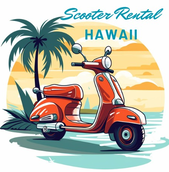With its breathtaking landscapes, warm tropical climate, and relaxed vibes, Hawaii is a paradise for many.
If you’re visiting the islands or living there and considering a moped as your mode of transportation, it’s essential to understand the local moped laws and regulations.
Hawaii’s unique geography and traffic conditions make it crucial for moped riders to be well-informed and safety-conscious.
In this article, we’ll explore the specific laws governing mopeds in Hawaii, ensuring you have a smooth and enjoyable ride through this tropical haven.
**While ScooterRentalHawaii.com is providing this information, let it be known that we are not a company dedicated to the law and this is not legal advice in any way. We have compiled a list of moped laws here, but they could be subject to change, and is always good to check with the local governmental sites for up-to-date legal information.
Moped Classifications in Hawaii
Hawaii categorizes mopeds into two classes based on engine size and speed capabilities:
Class A Mopeds
These mopeds or scooters have an engine displacement of 50cc or less, and their top speed is limited to 30 miles per hour on level ground.
Class A mopeds don’t require a motorcycle license, but riders must be at least 15 years old to operate them and need a valid driver’s license.
Class B Mopeds
Class B mopeds have engines larger than 50cc or can achieve speeds greater than 30 miles per hour.
To operate a Class B moped, riders must have a valid Class 2 motorcycle license or higher.
Riders must also be at least 18 years old.

Stay Legal, Stay Safe: Abiding by Hawaii’s Traffic Laws
Moped riders in Hawaii are subject to the same traffic laws as other motor vehicles. This means you must obey all traffic signals, signs, and lane markings. It’s vital to be aware of speed limits and adhere to them, as speeding on a moped can pose significant risks to your safety.
Lane Usage
In Hawaii, moped riders are generally expected to use the right-most lane, except when making a left turn or when the right-most lane is a dedicated right-turn lane.
Sidewalk Riding
Riding a moped on sidewalks is typically not allowed in Hawaii unless expressly permitted by local ordinances. It’s important to check the specific rules in your area, but as a general rule, it’s safer to stick to the road.
Bicycle Lanes
Moped riders shouldn’t use bicycle lanes. These lanes are intended for bicycles, not mopeds or other motorized vehicles. Using bicycle lanes can create hazards for cyclists and pedestrians.
Right of Way
As a moped rider, you must yield the right of way to pedestrians in crosswalks and at intersections. Don’t get lost; make sure you check out our Island Maps to ensure you’re getting around safely.
When approaching a stop sign or traffic signal, come to a complete stop and proceed when it’s safe to do so.
Turn Signals
Mopeds in Hawaii aren’t usually equipped with turn signals.
To signal your intentions to other road users, use hand signals when making turns. Extend your left arm horizontally to signal a left turn and upward to signal a right turn.
Riding Two Abreast
Hawaii law generally permits two moped riders to ride abreast in a single lane.
However, it’s essential to exercise caution and ensure you’re not obstructing other vehicles or impeding traffic flow.
Rider Age Restriction
According to Hawaii law:
- No person less than fifteen years of age shall drive a moped.
This age restriction ensures that young, inexperienced riders aren’t operating mopeds, promoting safety on the roads.
Proper Riding Posture
Hawaii law also specifies:
- No person shall drive a moped except while sitting astride the seat, facing forward, with one leg on each side of the moped.
This regulation emphasizes the importance of maintaining a proper riding posture for safety and control while operating a moped.
Passenger Restrictions
In Hawaii, it’s against the law to have more than one person on a moped. Only the driver is allowed to ride a moped. This rule is in place to prevent overloading and make sure that mopeds are operated safely, reducing the risk of accidents and injuries.
Riding Safely in Hawaii’s Varied Terrain
Hawaii’s landscapes offer diverse terrains, from winding coastal roads to steep mountain slopes. When riding a moped in Hawaii, consider the following safety tips:
- Be cautious when riding on hilly terrain, as steep inclines can affect your moped’s speed and handling.
- Keep a safe following distance from other vehicles and watch for sudden stops or turns.
- Be aware of the weather conditions, as rain can make roads slippery, particularly on steep slopes.
- Avoid distracted riding; focus on the road and traffic around you.
- Use extra caution when riding in areas with heavy tourist traffic, as pedestrians may not always be familiar with local traffic patterns.

Legal Loopholes: Persons Exempt from Driver’s License Requirements
Certain individuals are exempt from the requirement to obtain a driver’s license under specific circumstances. These exemptions are outlined as follows:
- Individuals who are at least eighteen years old and hold a valid driver’s license from another U.S. state or specific territory can drive certain types of vehicles in Hawaii without getting a Hawaii driver’s license.
- Individuals who possess a valid commercial motor vehicle driver’s license issued by any U.S. state, Mexico, or Canadian province that meets federal standards can also drive commercial vehicles in Hawaii without a Hawaii driver’s license.
Helmets: The Unwritten Rule of Safety
Hawaii law doesn’t require moped riders to wear helmets, but it’s essential to consider the benefits of doing so.
Helmets aren’t just a piece of equipment; they’re your shield against potential head injuries in the event of an accident.
In a state known for its diverse and sometimes challenging terrain, having that extra layer of protection can make a world of difference.
Why Helmets Matter
- Head Protection: Helmets are designed to absorb impact and protect your head from traumatic injuries. Even at lower speeds, a fall can lead to serious head injuries, which can be life-altering.
- Visibility: Helmets often come with visors or face shields that can help shield your eyes from debris, wind, and bugs, improving overall visibility and safety.
- Weather Protection: Hawaii’s weather can change rapidly. A helmet can provide shelter from rain, sun, and strong winds, enhancing your comfort and focus while riding.
- Reduced Wind Noise: Helmets can reduce the distracting wind noise, allowing you to concentrate better on the road and your surroundings.
Choosing the Right Helmet
If you decide to wear a helmet while riding your moped, it’s important to select one that provides the best protection and comfort. Here are some tips on choosing the right helmet:
- Certification: Look for helmets that meet or exceed safety standards, such as DOT (Department of Transportation) or Snell certifications. These helmets undergo rigorous testing to ensure their effectiveness.
- Fit: A well-fitting helmet is crucial. It should sit snugly on your head without being too tight or too loose. Make sure it doesn’t obstruct your vision.
- Visor or Shield: Consider whether you want a helmet with a visor or shield. A clear face shield can offer added protection and visibility.
- Ventilation: Hawaii’s climate can be warm and humid. Helmets with proper ventilation can help keep you cool and comfortable during your ride.
Additional Safety Gear
While helmets are a primary safety item, consider additional protective gear for a safer riding experience:
- Gloves: Protect your hands from abrasions, impacts, and the elements.
- Jackets and Riding Suits: Invest in clothing made of abrasion-resistant materials like leather or durable textiles to shield your skin in case of a fall.
- Boots: Sturdy, closed-toe footwear can help protect your feet and ankles.
- Eye Protection: Even if your helmet has a face shield, consider wearing sunglasses or goggles to safeguard your eyes from debris and sunlight.
Is a Muffler Mandatory for Mopeds in Hawaii?
Yes, a muffler is mandatory for mopeds in Hawaii. Mopeds must have functioning muffler systems in place to help reduce noise emissions.
This requirement helps ensure that mopeds operate within acceptable noise limits and comply with the state’s legal regulations regarding mufflers.
Operating a motor vehicle, whether it’s a motor scooter or a moped, without a muffler or with a modified exhaust system can result in legal penalties.
Law enforcement agencies in Hawaii can issue citations or fines to drivers who don’t comply with muffler regulations.
How Old Do You Have to Be to Rent a Moped in Hawaii?
To rent a moped in Hawaii, you need to be at least 18 years old.
Rental agencies often require renters to have an instruction permit or valid driver’s license. In some cases, they may also request a motorcycle endorsement on the license, depending on the engine size and speed capabilities of the rented moped.
What Is the Moped Speed Limit in Hawaii?
In Hawaii, the maximum speed limit for mopeds depends on the type of road you are traveling on and the specific local regulations. Here are some general guidelines:
- City Streets and Residential Areas: Mopeds are generally expected to adhere to the posted speed limits, which are typically 25 to 35 miles per hour on city streets and residential roads.
- County Roads: On county roads and highways, the speed limit for mopeds may vary but is typically in the range of 35 to 45 miles per hour.
- State Highways: Mopeds are not allowed on state highways with speed limits over 45 miles per hour, as they may not be able to safely travel at higher speeds.
Final Thoughts
Navigating Hawaii’s roads on a moped can be a fantastic way to explore the islands, but it’s essential to do so safely and responsibly. Understanding and adhering to the rules of the road will help ensure your safety and the safety of others while enjoying the natural beauty and unique terrain that Hawaii has to offer.







Your article helped me a lot, is there any more related content? Thanks!